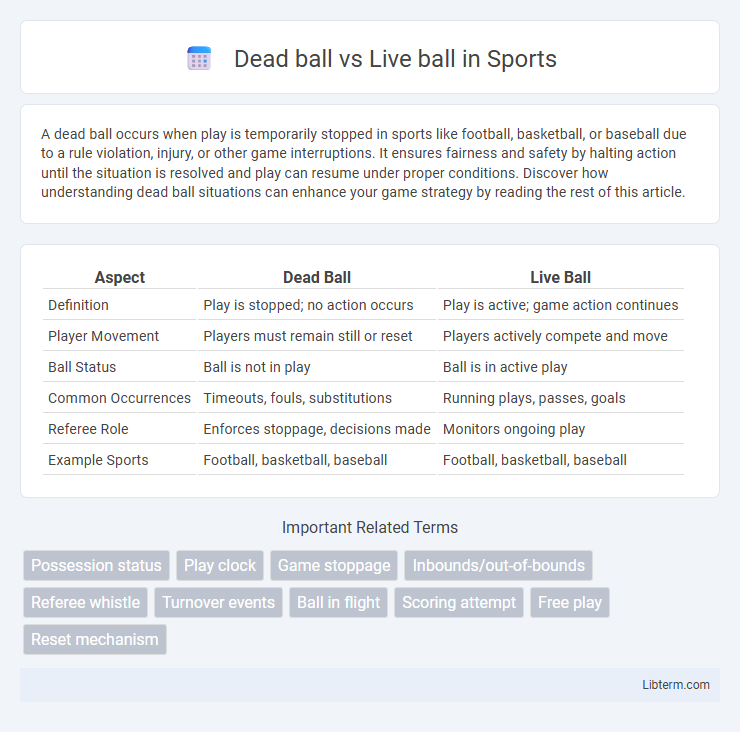A dead ball occurs when play is temporarily stopped in sports like football, basketball, or baseball due to a rule violation, injury, or other game interruptions. It ensures fairness and safety by halting action until the situation is resolved and play can resume under proper conditions. Discover how understanding dead ball situations can enhance your game strategy by reading the rest of this article.
Table of Comparison
| Aspect | Dead Ball | Live Ball |
|---|---|---|
| Definition | Play is stopped; no action occurs | Play is active; game action continues |
| Player Movement | Players must remain still or reset | Players actively compete and move |
| Ball Status | Ball is not in play | Ball is in active play |
| Common Occurrences | Timeouts, fouls, substitutions | Running plays, passes, goals |
| Referee Role | Enforces stoppage, decisions made | Monitors ongoing play |
| Example Sports | Football, basketball, baseball | Football, basketball, baseball |
Understanding Dead Ball and Live Ball
Dead ball refers to the state in a sporting event when play is temporarily halted, such as after a foul, timeout, or out-of-bounds ball, indicating no active competition on the field or court. Live ball denotes the period during which the game is actively in progress, players compete, and the ball is in motion, allowing scoring or strategic play. Understanding these concepts is crucial for interpreting game flow, referee decisions, and aligning with official rules in sports like basketball, football, and baseball.
Definition of a Dead Ball
A dead ball is a situation in sports when play is temporarily stopped and the ball is not in active play, preventing any player from making a legal move with it. This status occurs after specific events such as fouls, out-of-bounds, or timeouts, signaling a pause in the game's progression. Understanding the dead ball concept is essential for interpreting game rules and timing in sports like basketball, football, and baseball.
Definition of a Live Ball
A live ball in sports is defined as the period during which play is active and players can legally interact with the ball, affecting the game's outcome. Unlike a dead ball, when the game is paused and no actions impact the score or player advancement, a live ball allows continuous movement, scoring opportunities, and strategic plays. Understanding the concept of a live ball is crucial for athletes, referees, and fans to accurately interpret game dynamics and rule enforcement.
Key Differences Between Dead Ball and Live Ball
Dead ball periods occur when play is temporarily stopped, such as after a foul, out-of-bounds, or timeout, preventing players from advancing or scoring. Live ball phases happen when the game is actively in motion, allowing for continuous play, scoring opportunities, and strategic maneuvers. The key difference lies in the status of play control: dead ball halts game progression, while live ball maintains dynamic action and scoring possibilities.
Situations That Result in a Dead Ball
A dead ball occurs when play is stopped due to specific situations such as fouls, timeouts, or when the ball crosses out of bounds. Other instances resulting in a dead ball include a score, a held ball, or an inadvertent whistle by the referee. Understanding these moments is essential for players and officials to manage game flow and enforce rules accurately.
Scenarios Activating a Live Ball
A live ball is activated in scenarios such as the snap of the football in American football, the referee's whistle signaling play in soccer or basketball, and a pitcher's throw in baseball. It also becomes live when play resumes after stoppages like penalties, timeouts, or after scoring plays unless the rules specify otherwise. Understanding these moments is crucial for players and officials to recognize when actions can impact game outcomes.
Impact on Gameplay: Dead Ball vs Live Ball
Dead ball situations halt player movement and reset game strategy by stopping all active play, allowing teams to regroup and plan set-piece opportunities. Live ball conditions maintain continuous player interaction and dynamic gameplay, enabling fast transitions, quick attacks, and spontaneous tactical decisions. Understanding the shift between dead and live ball states is crucial for optimizing player positioning and exploiting opponent vulnerabilities during critical moments.
Referee’s Role in Dead Ball and Live Ball Situations
The referee plays a crucial role in managing dead ball and live ball situations by ensuring players adhere to the rules and maintaining game flow. During dead ball scenarios, the referee enforces restarts, checks for fouls, and communicates decisions clearly to prevent misunderstandings. In live ball situations, the referee monitors player actions closely to detect infractions, maintain safety, and uphold fair play throughout continuous play.
Common Misconceptions About Dead and Live Ball
Many believe the ball is automatically dead after any umpire's whistle, but in reality, a live ball remains in play until the umpire explicitly signals a dead ball. Another misconception is that fouls immediately stop the play, while some fouls result in live ball situations allowing continued action. Understanding the precise conditions for dead and live balls is crucial for accurate game calls in sports like baseball, football, and basketball.
Importance of Knowing Dead Ball and Live Ball Rules
Understanding the difference between dead ball and live ball situations is crucial in sports like football and baseball, as it directly impacts player positioning and game strategy. Dead ball rules determine when play is stopped, allowing for resets, substitutions, and penalty enforcement, while live ball conditions dictate continuous action and scoring opportunities. Mastery of these rules ensures compliance with official regulations and enhances the ability to anticipate game flow and make strategic decisions.
Dead ball Infographic

 libterm.com
libterm.com